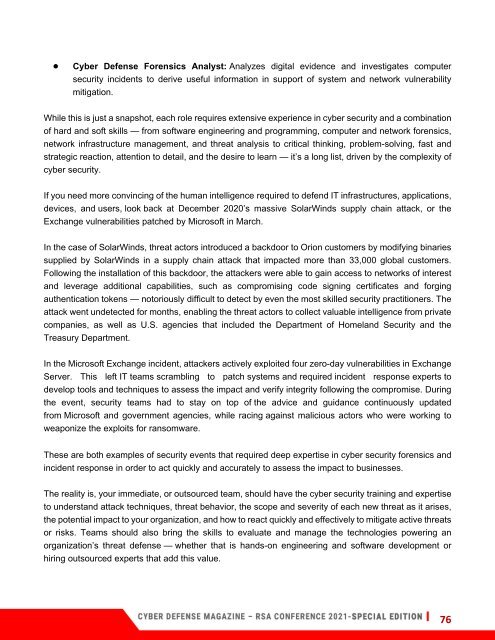Cyber Defense Magazine Special Annual Edition for RSA Conference 2021
Cyber Defense Magazine Special Annual Edition for RSA Conference 2021 - the INFOSEC community's largest, most popular cybersecurity event in the world. Hosted every year in beautiful and sunny San Francisco, California, USA. This year, post COVID-19, virtually with #RESILIENCE! In addition, we're in our 9th year of the prestigious Global InfoSec Awards. This is a must read source for all things infosec.
Cyber Defense Magazine Special Annual Edition for RSA Conference 2021 - the INFOSEC community's largest, most popular cybersecurity event in the world. Hosted every year in beautiful and sunny San Francisco, California, USA. This year, post COVID-19, virtually with #RESILIENCE! In addition, we're in our 9th year of the prestigious Global InfoSec Awards. This is a must read source for all things infosec.
You also want an ePaper? Increase the reach of your titles
YUMPU automatically turns print PDFs into web optimized ePapers that Google loves.
• <strong>Cyber</strong> <strong>Defense</strong> Forensics Analyst: Analyzes digital evidence and investigates computer<br />
security incidents to derive useful in<strong>for</strong>mation in support of system and network vulnerability<br />
mitigation.<br />
While this is just a snapshot, each role requires extensive experience in cyber security and a combination<br />
of hard and soft skills — from software engineering and programming, computer and network <strong>for</strong>ensics,<br />
network infrastructure management, and threat analysis to critical thinking, problem-solving, fast and<br />
strategic reaction, attention to detail, and the desire to learn — it’s a long list, driven by the complexity of<br />
cyber security.<br />
If you need more convincing of the human intelligence required to defend IT infrastructures, applications,<br />
devices, and users, look back at December 2020’s massive SolarWinds supply chain attack, or the<br />
Exchange vulnerabilities patched by Microsoft in March.<br />
In the case of SolarWinds, threat actors introduced a backdoor to Orion customers by modifying binaries<br />
supplied by SolarWinds in a supply chain attack that impacted more than 33,000 global customers.<br />
Following the installation of this backdoor, the attackers were able to gain access to networks of interest<br />
and leverage additional capabilities, such as compromising code signing certificates and <strong>for</strong>ging<br />
authentication tokens — notoriously difficult to detect by even the most skilled security practitioners. The<br />
attack went undetected <strong>for</strong> months, enabling the threat actors to collect valuable intelligence from private<br />
companies, as well as U.S. agencies that included the Department of Homeland Security and the<br />
Treasury Department.<br />
In the Microsoft Exchange incident, attackers actively exploited four zero-day vulnerabilities in Exchange<br />
Server. This left IT teams scrambling to patch systems and required incident response experts to<br />
develop tools and techniques to assess the impact and verify integrity following the compromise. During<br />
the event, security teams had to stay on top of the advice and guidance continuously updated<br />
from Microsoft and government agencies, while racing against malicious actors who were working to<br />
weaponize the exploits <strong>for</strong> ransomware.<br />
These are both examples of security events that required deep expertise in cyber security <strong>for</strong>ensics and<br />
incident response in order to act quickly and accurately to assess the impact to businesses.<br />
The reality is, your immediate, or outsourced team, should have the cyber security training and expertise<br />
to understand attack techniques, threat behavior, the scope and severity of each new threat as it arises,<br />
the potential impact to your organization, and how to react quickly and effectively to mitigate active threats<br />
or risks. Teams should also bring the skills to evaluate and manage the technologies powering an<br />
organization’s threat defense — whether that is hands-on engineering and software development or<br />
hiring outsourced experts that add this value.<br />
76


















